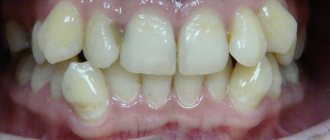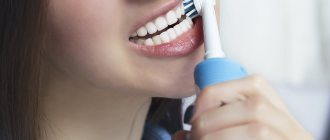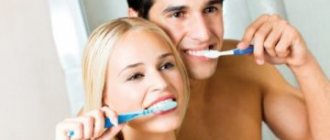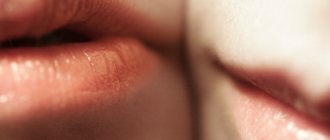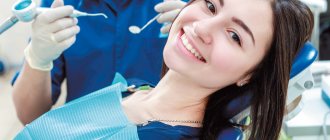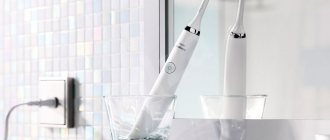During orthodontic treatment, patients experience difficulties with oral hygiene. This happens because the braces themselves and the arch that connects them prevent a regular toothbrush from cleaning plaque and food debris from the dental spaces. Moreover, the foreign complex structure itself becomes an additional source of infection, collecting the same food debris on the surface.
This problem can have serious consequences, since the dentist’s ability to prevent and treat caries while the patient is wearing braces is also significantly limited. Taking this fact into account, it is worthwhile to monitor oral hygiene as carefully as possible during the active phase of bite correction. You need to purchase everything for caring for braces from an online store or pharmacy. The dentist will definitely give you a list of necessary devices after installing the orthodontic structure.
Why do you need special care for your teeth after getting braces?
We have already considered the first and most important reason - braces interfere with the ability to effectively clean teeth from food and soft plaque. This is why brushing teeth with braces with a regular brush is ineffective. Over time, the plaque will begin to thicken and get rid of it will become even more difficult. Moreover, bad breath will become your constant companion, despite rinses and mouth fresheners. By the way, you will also not be able to use chewing gum due to the presence of the same braces in your mouth!
If caries has developed on a tooth, then before starting treatment, the dentist will remove the braces from it, suspending the process of correcting the bite until the end of therapy. In addition to the fact that this lengthens the overall treatment time, removing and reinstalling braces is a paid procedure. Therefore, careful dental care will not only allow you to quickly get the coveted “Hollywood” smile, but also prevent unnecessary financial expenses.
Conclusions. Expert advice
Wearing braces is a special time when your teeth require extra care. If it is important for you to keep your enamel in excellent condition and avoid caries, then you need to follow simple rules: brush your teeth regularly, use specialized products, change your diet so that food does not damage the orthodontic structure.
Dental care during the period of bite correction is performed using special means, namely:
- v shaped brush for braces with a special shape of bristles;
- single-tuft brushes that allow you to remove plaque and food debris from hard-to-reach places;
- brushes and specialized dental floss, with the help of which dental spaces are cleaned.
Care devices can be purchased individually or taken as a set. The set usually includes the minimum necessary items in a convenient package that you can carry with you to work or school.
Tools for caring for braces
Devices for caring for the oral cavity during orthodontic treatment may seem strange and uncomfortable at first glance, but they are not. If you are interested in where in Moscow you can buy an orthodontic toothbrush and brushes for cleaning braces, then just ask your dentist or search on the Internet. Today, most pharmacies and a large number of online stores offer a full range of hygiene products for patients undergoing orthodontic treatment. Moreover, the prices for these tools can vary, both from quite high for products of professional dental brands (for example, toothbrushes and brushes for Curaprox braces), and to absolutely affordable brushes from mass market brands (toothbrushes and brushes for Oral braces B (oral bi).
What is not recommended to do
Under no circumstances should toothpicks be used. They are not recommended even for those who do not have dental problems. This damages the enamel and injures the gums.
It is also forbidden to chew gum, as it easily gets stuck in the clasps and gets into the space between the tooth and the arch. All this leads to incorrect use of braces.
If you have braces, it is better not to use electric toothbrushes. Due to too rapid rotation, small bristles can damage the structure, which will lead to consequences.
How to care for your teeth after getting braces?
In general, the basic principles of dental care remain unchanged:
- Actively brush your teeth 2 times a day – morning and evening.
- Cleanse as needed each time after eating.
- Visit your dentist regularly for preventive professional hygiene.
However, taking into account the presence of braces on the teeth, each of these stages becomes longer and requires the use of completely special tools.
Orthodontic brush for cleaning braces
An orthodontic toothbrush looks similar to a regular one, however, the special arrangement of the bristles on its head attracts attention. Firstly, such brushes are available only with soft hairs or medium hardness. Secondly, the length of the hair varies from the longest at the edge to the shortest in the middle of the brush. Thus, their appearance resembles the letter V. Today, buying a toothbrush for braces in pharmacies is quite simple, since such a model is already included in the portfolio of almost all well-known brands from the economy to the luxury segment.
How to properly brush teeth with braces with an orthodontic toothbrush? The process will take place in three stages:
- Horizontal movements clean the vestibular (outer) surface of the dentition (where the braces are located). If you have a lingual structure, then horizontal movements are made accordingly from the inside, moving along the length of the arch.
- We place the toothbrush at an angle of 450 to the surface of the gum and carefully, with slight pressure, clean the structure itself and the spaces under the arch.
- We brush our teeth as usual from the inside (outside if the braces are lingual).
How to clean braces with a brush?
If few people can be surprised by a set of brushes for braces, then special brushes are a completely new tool in the arsenal of an ordinary person. The brush is a small vertical brush, with which it is very convenient to clean the interdental spaces.
In addition, a brush is indispensable for cleaning the surface of the tooth under the arch connecting the braces. It is necessary to carefully insert it under the arc and rotate it clockwise to remove plaque and stuck food particles.
An important rule of hygiene is the life of the brush. If an orthodontic toothbrush is ready to serve its owner for the standard 2-3 months, then the brush needs to be changed every 2 weeks. Typically, orthodontic brushes for cleaning braces are sold in sets of several pieces for the convenience of patients.
How to use a mono-beam brush for braces?
In the photo, the monotuft brush for braces resembles the letter “G”. This is a miniature tuft of bristles that is attached at an angle to a long handle. It must be used with special sweeping movements, moving from the neck of the tooth to its crown. It is very convenient to use such a brush to clean the bracket itself, since in addition to one small beam, the working head is also small in size and allows you to look into the most difficult to reach places.
Some brands offer to buy multifunctional brushes with different attachments for braces and more thorough oral hygiene in general. In this case, it is worth paying attention to the overall ergonomics of the design. The handle should fit comfortably in the hand (ideally have rubber stops or notches), and the attachments themselves should be firmly attached to it.
As for bristles, when caring for orthodontic structures, you should choose brushes with soft and medium hardness, so as not to damage the miniature structures.
How to use an electric toothbrush for braces?
Some patients are interested in whether it is possible to clean braces with an electric or ultrasonic brush? You can, however, choose models that are equipped with special attachments. As a rule, such a nozzle looks like a single-tuft brush with a slightly larger diameter. The brush itself should be made of soft or medium bristles. An important feature of orthodontic electric brushes is the presence of a special low-intensity mode, which will prevent the braces themselves from being damaged during cleaning. Typically, manufacturers of high-quality models post a video on the Internet about how to properly brush teeth with braces, and provide in the instructions a link to it or to a proprietary application that needs to be installed on your phone.
Brushing teeth with braces using floss
Ordinary dental floss has become so firmly established in our lives that daily high-quality hygiene without it seems impossible. Should I give it up during orthodontic treatment? Is it possible to brush teeth with braces with regular floss? Of course it is possible, orthodontists answer, however, it will be more effective to use superfloss instead of regular thread.
Superfloss is essentially dental floss, however, it combines several functions. For example, one of the brands widely represented on the dental market produces threads with a hard tip, which allows it to be inserted under the arch of an orthodontic structure. In the middle of the piece of thread there is a part of spongy porous fiber for more thorough removal of food debris.
How to clean braces with an irrigator?
The irrigator is a universal device for oral hygiene, which is also suitable for cleaning braces. The essence of the method is that water is applied to the teeth under high pressure. In this way, you can gently and effectively remove food debris from the interdental spaces and plaque from the surface of the teeth without damaging the orthodontic structures themselves.
If necessary, rinse aid or disinfectant solutions suitable for use in dentistry can be added to the water container.
Nutrition while wearing braces
Until you have adjusted to braces, you need soft or liquid foods. Introduce new foods into your diet gradually. During the adjustment period, exclude the following foods.
- Solid products
. First you need to grind them in a blender. Lollipops, crackers and nuts should also be removed from the diet for a while. - Food that is too cold or hot
. During the period of adaptation, the sensitivity of teeth and gums increases and discomfort and pain may appear.
The menu should consist of foods that do not need to be thoroughly chewed:
- fermented milk drinks (kefir, yogurt, fermented baked milk);
- boiled cereals (semolina, buckwheat, wheat, oatmeal);
- meat in the form of pate;
- puree soups;
- jelly and curd mass:
- bananas, watermelons, apricots, plums and persimmons.
After adaptation, the list of foods on the menu will expand, but dentists still recommend excluding the following from the diet.
- Everything sticky
- nougat, chewing gum, toffee, caramel and anything that stretches. These products get stuck in the design parts and become food for bacteria. - Starch
- baked goods, cereals and corn sticks - also, when stuck in braces, causes the growth of harmful microorganisms. - Coloring drinks and food
- black tea, colored soda, coffee, beets, wine. This is especially important if ceramic or sapphire structures are installed - they are easier to paint than others.
What toothpaste should you use to brush your teeth with braces?
Most often, braces care kits sold in stores include toothpastes with a high content of fluoride or calcium. This is justified by the fact that the orthodontic system has a negative effect on tooth enamel, slightly thinning it. However, dentists do not recommend frequent use of fluoridated toothpastes while wearing braces, as this may cause staining of the enamel. They will become especially noticeable after the system is removed and will require additional measures to restore the aesthetics of the smile.
From the point of view of doctors, the patient is recommended to concentrate his efforts on regular mechanical cleaning of teeth from plaque and food, without being carried away by the excessively abrasive and mineralizing effects of toothpastes.
What products will be needed for care?
To ensure thorough care of an orthodontic structure such as braces, a set of hygienic measures is needed. The following devices and tools will help provide them.
- Toothbrush.
It should have soft bristles that will not damage the structure. You can purchase a special orthodontic one. V-neck model with stubble.
- Paste with calcium and fluoride.
These substances in toothpaste will strengthen the enamel and help prevent the risk of damage.
- Ershik.
Special brushes help remove food debris and plaque from under the metal arch and around the brackets.
- Super floss.
Orthodontic dental floss designed specifically for cleaning braces, dentures and other dental structures.
- Irrigator.
This device is ideal for gentle and effective care of braces. To clean them of dirt, you need to buy a device with a special orthodontic attachment. The irrigator cleans the structure using a water jet under pressure and, additionally, the mechanical action of the bristles of the nozzle.
- Mouth rinse solution.
Its use soothes the gums and prevents the growth of bacteria.
Additional activities after cleaning
In addition to directly brushing teeth during orthodontic treatment, some other manipulations may be required to improve the patient’s quality of life - this is rinsing the mouth and working with wax.
Mouthwash
Dentists recommend using mouthwash daily. This allows you to quickly freshen your breath, while chewing gum remains an unaffordable luxury for patients with braces.
In addition, regular rinsing of the mouth with antiseptic solutions helps relieve inflammation, which especially often makes itself felt in the first days of wearing braces.
Why do you need wax?
If you buy a set for cleaning braces, then in the vast majority of cases it will also contain wax in addition to the already familiar listed tools. Why is it needed?
It is no secret that the sharp edges of braces and even the arch can cause microtrauma to the mucous membrane of the tongue, lips and cheeks. This is especially noticeable in the first 2-3 weeks of wearing braces, when all the known shortcomings of this orthodontic system are maximally manifested.
To avoid the formation of wounds, bleeding and generally improve the patient’s quality of life and increase his loyalty to treatment, orthodontists recommend the active use of wax. A small amount of it must be kneaded in your hands and applied to the part of the bracket with sharp edges. Gradually, this will no longer be necessary, as the oral mucosa adapts to the structure on the teeth.
Recommendations
You can increase the effectiveness of this procedure if you follow certain recommendations:
- It is most convenient to cleanse in front of a mirror . This way you can track every movement and direction of the thread.
- Before using floss, it is recommended to clean with a special orthodontic brush .
Its bristles have a V-shaped cut, where the short central bristles efficiently process the surface of the braces, while the long outer bristles remove plaque from the enamel. - When pulling the floss under the arc, you should try not to touch its surface , as the fibers can catch on the structure and lead to its deformation or breakage.
- It should be borne in mind that the cleaning procedure with braces will be much longer than without them.
- To make it easier to position the floss under the orthodontic appliance, It is recommended to use a special device - a dental floss threader.
It is a small plastic structure that looks like a needle.During use, the tip of the floss is inserted into the eye of the threader, in the same way as a regular thread is inserted into a sewing needle. Then, the threader is pushed under the wire arch of the bracket system, while simultaneously pulling the floss under it.
After this, the thread is released from the auxiliary device and cleaned in a standard manner. The threader is used to clean each segment. This will speed up the procedure and more accurately position the floss.
- During the procedure, do not put too much pressure on the surface of the tooth when removing plaque, as this can damage the enamel.
- If, after the first application of floss, small drops of blood appear on the gums without painful manifestations, do not panic .
After a few days of daily use, gum bleeding will stop. If this does not happen, and the gums continue to bleed, you need to seek help from a dentist. - If a child wears braces, then cleaning should take place under the supervision of the parents . For young children, it is advisable for parents to thread the thread under the orthodontic structure themselves.
Which irrigator for braces should you choose for quality care?
Detailed description of dentin dysplasia.
Let's discuss the Mershona apparatus https://orto-info.ru/sistemyi-vyiravnivaniya-zubov/lechebno-profilakticheskie-apparatyi/mershona.html via the link.
Is it possible to have professional cleaning with braces?
It is worth noting that professional teeth cleaning by a dentist is mandatory before installing and after removing braces. In the first case, this allows you to remove stone and plaque from the surface of the tooth in order to:
- Minimize the risk of developing caries during orthodontic treatment;
- Ensure better attachment of the bracket plate to the tooth surface.
Accordingly, at the end of treatment, the doctor removes plaque that has settled on the teeth due to difficulties with hygiene, and thus evens out the color of the teeth.
If the patient is indicated for long-term wearing of braces - longer than six months, then professional cleaning is carried out at the agreed time or according to the doctor's indications. In this case, there is no need to remove the braces themselves; you just need to remove the arches for the duration of cleaning (and even then not always).
The price of professional teeth cleaning with braces at a dentist in Moscow is slightly higher than that for other categories of patients.
Sequence of procedure
Today you can find several methods for cleaning braces. Each of them has its own advantages and disadvantages.
Not long ago, the American Association of Dental Hygienists analyzed all existing techniques, highlighting the most effective technical elements from them and creating the correct brushing technique. It consists of just a few steps that are easy to perform and do not require special skills to carry out:
- To begin the procedure, you need to cut off a small section of the floss.
As a rule, 20 cm of thread is enough for cleaning. Its tip should be wrapped around the index finger of one hand. Then, leaving an interval of about 2 cm, the thread is clamped with the index finger and thumb of the other hand. To prevent slipping, it is also recommended to wrap the floss around your index finger. - Using your thumbs as guides, begin brushing from the top row of teeth, after first pulling the measured length tightly.
First, it is inserted under the metal arch of the system, and then directed between the teeth, making zigzag movements, first up and then down. In this case, it is necessary to carefully grasp a small area under the gum, avoiding sudden movements, so as not to injure the periodontal tissue. - After the interdental spaces, they begin to clean the surface of the tooth by threading it.
To remove plaque, you should distribute it around the tooth so that the floss lies immediately on the side and back surfaces. Cleaning is carried out by moving up and down, also capturing the subgingival area. For each tooth you need to take a new piece of thread. - Having cleaned all the teeth of one row, they begin to clean the braces system and the space between its elements.
To do this, the thread is inserted under the metal arch of the structure and moving up and down, moving it from the base of one bracket to the base of the other. In this case, you need to touch the surface of the arc with floss, removing dirt from it. Then, having measured out the next segment, they begin to clean the next segment. - After cleaning the dentition of the upper jaw, proceed to the lower row. The index fingers are used as guides here, with which all manipulations are performed in the same order as when cleaning the upper teeth and braces.
During the procedure, the use of the same section of floss for different teeth or segments is not allowed , since a large number of bacteria have already collected on it. As a result, cleansing will be ineffective and will require the use of additional hygiene products.
To improve the quality of the hygiene procedure, it is recommended to finish it by rinsing with a special balm.
An example of cleaning in the following video:
Why are Pure braces so good and do they have any disadvantages?
Let's talk about the Nance apparatus in this publication.
Let's discuss the link https://orto-info.ru/sistemyi-vyiravnivaniya-zubov/breketyi/po-tipu-materiala/metallicheskie/alexander.html Alexander bracket system.
Why do you need to have your braces cleaned at the dentist?
In addition to a number of rules for ensuring the necessary oral hygiene when wearing braces, which the patient must perform independently, there is a need to clean the system itself.
It is performed by a dentist at least twice a year, and even better - every three months. The need for the procedure is due to the fact that even the most thorough self-cleaning of the bracket system is not able to ensure 100% removal of plaque and hard-to-reach places. That is why orthodontists at Doctor Nearby recommend their patients to schedule it, just like visits for system correction.
Its implementation is carried out in accordance with the traditional scheme, but requires even more care and thoroughness from the specialist. The process may involve the “AirFlow” method to remove plaque, as well as ultrasound, which allows you to eliminate hard deposits near the gums and eliminate the appearance of unsightly whitish spots on the teeth.
air flow
It is important to understand that you should start doing professional oral cleaning before installing orthodontic systems. As a rule, this is a prerequisite before starting treatment. In this case, any method of cleansing is suitable, since they all allow you to cope with hard deposits and small particles of food in the interdental spaces.
The Air Flow procedure is painless and cannot damage the structure of even the most fragile braces, so its use is approved by all dentists and orthodontists. Cleaning should be done when a large accumulation of plaque is detected, as well as to prevent its occurrence. However, even when using such technology, there are a number of nuances that should be taken into account.
Usually the doctor works with a regular aqueous solution, which is applied to the surface of the enamel under strong pressure. This jet instantly removes deposits and massages the gums well, improving blood circulation. The result after the procedure lasts for a long time.
Professional hygiene in our clinic. TOP 7 advantages:
1. We take the procedure as seriously as we treat dental treatment! Occupational hygiene is carried out only by certified specialists with extensive experience.
2. Always individual selection of methods, means and materials. We initially take into account all your characteristics (increased sensitivity of teeth, inflammatory diseases of periodontal tissues, the presence of installed implants, etc.) and carry out professional hygiene with high quality and accuracy.
3. To remove dental plaque, we use a special powder that does not change the structure of the enamel in any way!
4. Our doctors use plaque indicators to visually control the quality of cleaning of all tooth surfaces.
5. The cost of professional hygiene already includes fluoridation and remotherapy (enamel strengthening).
6. If you are afraid of any dental procedures, we can perform professional hygiene under sedation (with nitrous oxide).
7. We will teach you proper home hygiene. We will select care products for you based on your needs. We will teach you how to effectively use electric or manual brushes. We will select brushes and dental floss, and teach you how to clean the contact surfaces of teeth.
